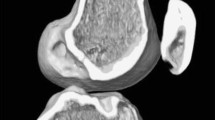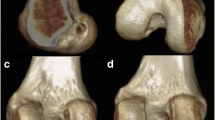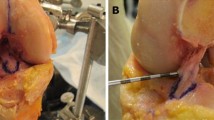Abstract
Introduction
The purposes of this study were: (1) to compare tunnel locations using the conventional transtibial technique with reference data, and (2) to identify factors that make it difficult to position the femoral tunnel correctly or contribute to breakage of the bone bridge between the two tibial tunnels.
Materials and methods
A prospective study was performed on 28 patients who underwent double bundle ACL reconstruction. Locations of each tunnel were determined using an anatomic coordinate axes method (ACAM). Measurements included: thickness of the bone bridge between tibial two tunnels (BB), height from the union (HU) point to expected joint surface, the ratio between the length of Blumensaat’s line and the anterior–posterior length of the lateral femoral condyle (RBL), and the ratio between anterior–posterior and proximal–distal lengths of the medial wall of the lateral femoral condyle (RAPPD).
Results
The posterior–anterior direction of femoral AM tunnel, the proximal–distal direction of femoral PL tunnel, and the posterior–anterior direction of femoral PL tunnel were statistically significantly different from the reference data. In correlation analyses between BB or HU and other variables, the AM tibial tunnel and RBL showed a moderate negative correlation. The cutoff point for tunnel breakage was an RLB of 1.14, meaning that the possibility of bone bridge breakage would increases for RBL values of >1.14.
Conclusions
It seems that conventional transtibial drilling technique used during double bundle ACL reconstruction does not reproduce correct tunnel locations compared with reference data. This problem was found to be related to the bony geometry of the medial wall of the lateral femoral condyle or the bone bridge between the two tibial tunnels. Our results indicate that RBL should be determined by pre-operative CT or plain lateral radiography, and that transtibial single bundle reconstruction or double bundle reconstruction using other methods should be attempted when the RBL exceeds 1.14.





Similar content being viewed by others
References
Aglietti P, Giron F, Cuomo P, Losco M, Mondanelli N (2007) Single-and double-incision double-bundle ACL reconstruction. Clin Orthop Relat Res 454:108–113
Ahn JH, Lee YS, Ha HC (2008) Comparison of revision surgery with primary anterior cruciate ligament reconstruction and outcome of revision surgery between different graft materials. Am J Sports Med 36:1889–1895
Ahn JH, Lee YS, Yoo JC, Chang MJ, Koh KH, Kim MH (2010) Clinical and second-look arthroscopic evaluation of repaired medial meniscus in anterior cruciate ligament-reconstructed knees. Am J Sports Med 38:472–477
Ahn JH, Park JS, Lee YS, Cho YJ (2007) Femoral bioabsorbable cross-pin fixation in anterior cruciate ligament reconstruction. Arthroscopy 23:1093–1099
Alentorn-Geli E, Samitier G, Alvarez P, Steinbacher G, Cugat R (2010) Anteromedial portal versus transtibial drilling techniques in ACL reconstruction: a blinded cross-sectional study at two- to five-year follow-up. Int Orthop 34:747–754
Basdekis G, Christel P, Anne F (2009) Validation of the position of the femoral tunnels in anatomic double-bundle ACL reconstruction with 3-D CT scan. Knee Surg Sports Traumatol Arthrosc 17:1089–1094
Chang CB, Yoo JH, Chung BJ, Seong SC, Kim TK (2010) Oblique femoral tunnel placement can increase risks of short femoral tunnel and cross-pin protrusion in anterior cruciate ligament reconstruction. Am J Sports Med 38:1237–1245
Chen CH, Chang CH, Su CI, Wang KC, Liu HT, Yu CM, Wong CB, Wang IC (2010) Arthroscopic single-bundle anterior cruciate ligament reconstruction with periosteum-enveloping hamstring tendon graft: clinical outcome at 2–7 years. Arthroscopy 26:907–917
Forsythe B, Kopf S, Wong AK, Martins CA, Anderst W, Tashman S, Fu FH (2010) The location of femoral and tibial tunnels in anatomic double-bundle anterior cruciate ligament reconstruction analyzed by three-dimensional computed tomography models. J Bone Jt Surg Am 92:1418–1426
Gavriilidis I, Motsis EK, Pakos EE, Georgoulis AD, Mitsionis G, Xenakis TA (2008) Transtibial versus anteromedial portal of the femoral tunnel in ACL reconstruction: a cadaveric study. Knee 15:364–367
Gelber PE, Reina F, Torres R, Monllau JC (2010) Effect of femoral tunnel length on the safety of anterior cruciate ligament graft fixation using cross-pin technique: a cadaveric study. Am J Sports Med 38:1877–1884
Hantes ME, Liantsis AK, Basdekis GK, Karantanas AH, Christel P, Malizos KN (2010) Evaluation of the bone bridge between the bone tunnels after anatomic double-bundle anterior cruciate ligament reconstruction: a multidetector computed tomography study. Am J Sports Med 38:1618–1625
Harner CD, Poehling GG (2004) Double bundle or double trouble? Arthroscopy 20:1013–1014
Inoue M, Tokuyasu S, Kuwahara S, Yasojima N, Kasahara Y, Kondo E, Onodere S, Yasuda K (2010) Tunnel location in transparent 3-dimensional CT in anatomic double-bundle anterior cruciate ligament reconstruction with the trans-tibial tunnel technique. Knee Surg Sports Traumatol Arthrosc 18:1176–1183
Jepsen CF, Lundberg-Jensen AK, Faunoe P (2007) Does the position of the femoral tunnel affect the laxity or clinical outcome of the anterior cruciate ligament-reconstructed knee? A clinical, prospective, randomized, double-blind study. Arthroscopy 23:1326–1333
Kopf S, Forsythe B, Wong AK, Tashman S, Anderst W, Irrgang JJ, Fu FH (2010) Nonanatomic tunnel position in traditional transtibial single-bundle anterior cruciate ligament reconstruction evaluated by three-dimensional computed tomography. J Bone Jt Surg Am 92:1427–1431
Lee YS, Ahn JH, Lim HC, Kim JG, Yoo JH, Wang JH, Park JS (2009) Structural change of soft tissue anterior cruciate ligament reconstructions with cross-pin fixation between immediate and postoperative 8 weeks: a study with use of magnetic resonance imaging. Am J Sports Med 37:285–290
Lee YS, Kim SK, Park JH, Park JW, Wang JH, Jung YB, Ahn JH (2007) Double-bundle anterior cruciate ligament reconstruction using two different suspensory femoral fixation: a technical note. Knee Surg Sports Traumatol Arthrosc 15:1023–1027
Lewis PB, Parameswaran AD, Rue JP, Bach BR Jr (2008) Systematic review of single-bundle anterior cruciate ligament reconstruction outcomes: a baseline assessment for consideration of double-bundle techniques. Am J Sports Med 36:2028–2036
Pinczewski LA, Salmon LJ, Jackson WF, von Bormann RB, Haslam PG, Tashiro S (2008) Radiological landmarks for placement of the tunnels in single-bundle reconstruction of the anterior cruciate ligament. J Bone Jt Surg Br 90:172–179
Silva A, Sampaio R, Pinto E (2010) Placement of femoral tunnel between the AM and PL bundles using a transtibial technique in single-bundle ACL reconstruction. Knee Surg Sports Traumatol Arthrosc 18:1245–1251
Steiner ME, Battaglia TC, Heming JF, Rand JD, Festa A, Baria M (2009) Independent drilling outperforms conventional transtibial drilling in anterior cruciate ligament reconstruction. Am J Sports Med 37:1912–1919
Yasuda K, Kondo E, Ichiyama H, Tanabe Y, Tohyama H (2006) Clinical evaluation of anatomic double-bundle anterior cruciate ligament reconstruction procedure using hamstring tendon grafts: comparisons among 3 different procedures. Arthroscopy 22:240–251
Zantop T, Wellmann M, Fu FH, Petersen W (2008) Tunnel positioning of anteromedial and posterolateral bundles in anatomic anterior cruciate ligament reconstruction: anatomic and radiographic findings. Am J Sports Med 36:65–72
Author information
Authors and Affiliations
Corresponding author
Rights and permissions
About this article
Cite this article
Lee, Y.S., Lee, B.K., Moon, D.H. et al. Comparison of tunnel locations of double bundle ACL reconstruction using the conventional transtibial technique with anatomic tunnel locations using a 3D CT model. Arch Orthop Trauma Surg 133, 1121–1128 (2013). https://doi.org/10.1007/s00402-013-1780-z
Received:
Published:
Issue Date:
DOI: https://doi.org/10.1007/s00402-013-1780-z




